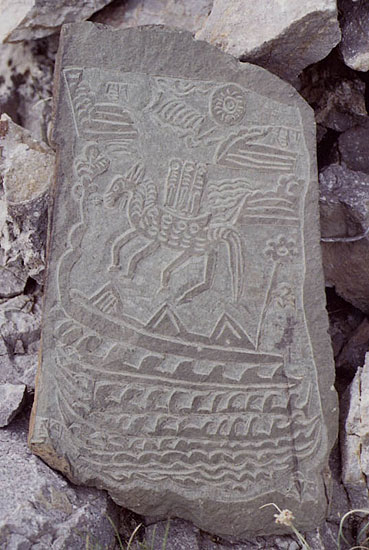previous image || Metal and Stone Vestiges main article || next image
Metal
and Stone Vestiges
Religion, Magic and Protection in the Art of Ancient Tibet
Image 8a
This rare inscribed plaque dates to pre-Communist times. While its precise age is open to question, this carving presents a completely indigenous version of the lungta, the wind-horse of Tibetan prayer flag. Unlike, the well-known lungta printed on cloth, which usually feature Buddhist motifs and symbols, this plaque presents a superb native form of this good luck-generating device. According to Tibetan tradition, the lungta originated in pre-Buddhist times but this remains difficult to corroborate. The discovery of this plaque in Upper Tibet however, does demonstrate that a fully integral native variant of the lungta was in artistic circulation. On the four corners of the plaque, the names of the warrior gods (dralha)
of the lungta are written: khyung, dragon (druk),
lion (seng), and tiger (tak). These gods guard the
four quarters of the universe and bring their supplicants power, wealth
and martial prowess. The wind-horse is shown in its typical aspect prancing
in the sky. On the horse’s back are the three jewels of good fortune,
which in Buddhist tradition are tantamount to the three foundations
of the religion: Buddha, Dharma, Religious Community (Konchok Sum).
The wind-horse is flanked by clouds and the sun rises high above it.
This bearer of good luck is soaring above the mountains depicted in
the carving as three pyramidal shapes. Below the three big mountains
are the choppy and wavy lines of water, representing the ocean or one
of the large Tibetan lakes. From in between the mountains and water
spring up two plants or trees flanking both sides of the wind-horse.
Symbolic of all life, the vegetation originates from the commingling
of the mountains and water, an ancient mythic theme. In both the oral
tradition and Bon literature, there are accounts of male mountains mating
with female lakes to engender the various beings of the universe. |
all text & images © John Vincent Bellezza
previous image || Metal and Stone Vestiges main article || next image
